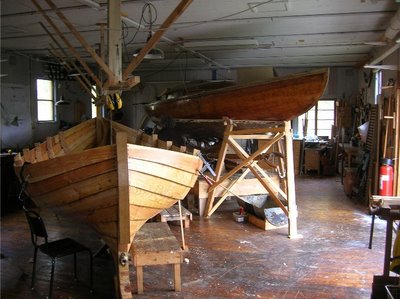Summer on Sandhamn...
So, one day after dragging himself up from the cold, dim depths of the Vasa Museum's collections storage area, Ole announced that he wanted to go out to the islands. Knowing I was always game for a little adventure and exploration, He invited me to come along.
 On a bright, sunny morning, I met Ole and Annette at the ferry dock and we boarded the Cinderella II for Sandhamn (I was hoping to get through life without ever having to ride on a vessel with such a name).
On a bright, sunny morning, I met Ole and Annette at the ferry dock and we boarded the Cinderella II for Sandhamn (I was hoping to get through life without ever having to ride on a vessel with such a name).  Before long, she throttled up and we went skittering out of the harbor past the Djurgården ferries, the crowded amusement park, the overloaded busses, and then on out past the cruiseship berths (where the Jewel of the Seas was moored, quite possibly the largest cruiseship I've ever seen, dwarfing the competition).
Before long, she throttled up and we went skittering out of the harbor past the Djurgården ferries, the crowded amusement park, the overloaded busses, and then on out past the cruiseship berths (where the Jewel of the Seas was moored, quite possibly the largest cruiseship I've ever seen, dwarfing the competition).  We trotted along the shore past all the rich Stockholmers' summer cabins, and snaked our way through incredibly narrow channels--sometimes having leafy tree branches swishing along the ship's stacks, and once, a very outraged powerboat skipper thumping along the hull.
We trotted along the shore past all the rich Stockholmers' summer cabins, and snaked our way through incredibly narrow channels--sometimes having leafy tree branches swishing along the ship's stacks, and once, a very outraged powerboat skipper thumping along the hull. ...and then beyond the city limits into the wild, forested islands. Freedom!
...and then beyond the city limits into the wild, forested islands. Freedom!
 Swinging by the last finger of the mainland, we paused in Waxholm, the old gateway to the approaches to Stockholm. There, the mighty island fortress still sits amid the narrow channel, bristling with cannon. Then, after exchanging a few passengers, we moved on.
Swinging by the last finger of the mainland, we paused in Waxholm, the old gateway to the approaches to Stockholm. There, the mighty island fortress still sits amid the narrow channel, bristling with cannon. Then, after exchanging a few passengers, we moved on. She was a noisy, stinky little gas-guzzler of a ferry, but under the practiced hands of her laid-back pilot, she skipped her way through the islands, nosing into little docks here and there like a bumblebee in a poppy field.
She was a noisy, stinky little gas-guzzler of a ferry, but under the practiced hands of her laid-back pilot, she skipped her way through the islands, nosing into little docks here and there like a bumblebee in a poppy field. Then we arrived at Sandhamn. What a beautiful little island.....
Then we arrived at Sandhamn. What a beautiful little island..... The little village of Sandhamn, a cluster of houses near the ferry landing, was charming beyond description from its little fisherman's boathouses...
The little village of Sandhamn, a cluster of houses near the ferry landing, was charming beyond description from its little fisherman's boathouses... ...to its gated yards overlooking the sea...
...to its gated yards overlooking the sea... ...to its overgrown gardens...
...to its overgrown gardens... ...and pleasing refinements.
...and pleasing refinements. Crossing to the island's Baltic side, we found even more remarkable places bearing all the trademarks of traditional rural Swedish living.
Crossing to the island's Baltic side, we found even more remarkable places bearing all the trademarks of traditional rural Swedish living. Then, after this short walk through the scrubby, windblown pine forest, we came to the luscious sands of Sandhamn's seaward shore. The water was still icy, saving us from the coming summer crowds, but the beach was still wonderful... and the view out over that open water to the horizon!
Then, after this short walk through the scrubby, windblown pine forest, we came to the luscious sands of Sandhamn's seaward shore. The water was still icy, saving us from the coming summer crowds, but the beach was still wonderful... and the view out over that open water to the horizon!  However, I found evidence that Sandhamn was not always an idyllic haven. On its rocky points stand the remains of numerous gun emplacements watching over the approaches to Stockholm and the mainland coast.
However, I found evidence that Sandhamn was not always an idyllic haven. On its rocky points stand the remains of numerous gun emplacements watching over the approaches to Stockholm and the mainland coast. Having been raised in the Pacific Northwest, I naturally had to go 'mucking about' in the rocky tidepools.
Having been raised in the Pacific Northwest, I naturally had to go 'mucking about' in the rocky tidepools.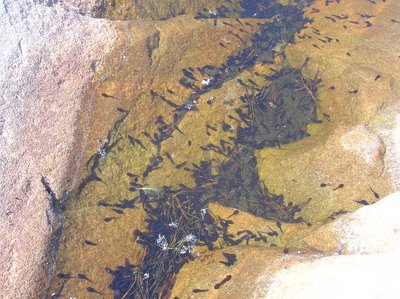 However, as there is no tide here and salinity is low to begin with, the tidepools were just full of tadpoles.
However, as there is no tide here and salinity is low to begin with, the tidepools were just full of tadpoles. As the aimless afternoon wore on, we decided it was time to hustle back to Sandhamn village to get to the dock and meet the boat.
As the aimless afternoon wore on, we decided it was time to hustle back to Sandhamn village to get to the dock and meet the boat. Back aboard the Cinderella II, we churned up the waters and streaked for home.
Back aboard the Cinderella II, we churned up the waters and streaked for home. We hit all the little stops along the way, checking in at one little island after another like the Skärgård steamers ahve been doing out here for more than a century. At this spot, a cow came down to the dock to see off a human friend, and thus satisfied, trotted home.
We hit all the little stops along the way, checking in at one little island after another like the Skärgård steamers ahve been doing out here for more than a century. At this spot, a cow came down to the dock to see off a human friend, and thus satisfied, trotted home.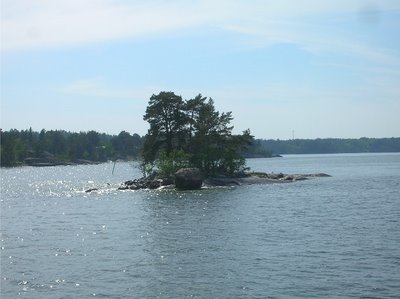 Dashing along through the sparkling waters, dodging little islets and the ominous green glow of submerged rocks, we roared further and further from the open sea.
Dashing along through the sparkling waters, dodging little islets and the ominous green glow of submerged rocks, we roared further and further from the open sea.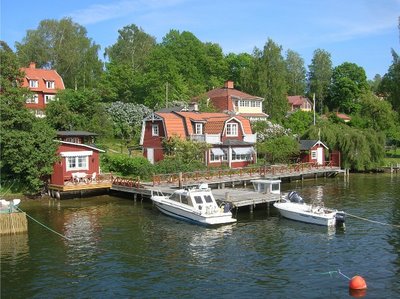 Soon we were weaving down those little channels again past all the expensive summer homes and plastic yachts.
Soon we were weaving down those little channels again past all the expensive summer homes and plastic yachts. There were still a few bold Baltic navigators raising sail and poking about these inner parts of the archipelago, but the city was drawing nigh.
There were still a few bold Baltic navigators raising sail and poking about these inner parts of the archipelago, but the city was drawing nigh. Before long the gates to Stockholm hove into sight, the Waxholm fortress. There it stood center channel, challenging all those who dared to pass.
Before long the gates to Stockholm hove into sight, the Waxholm fortress. There it stood center channel, challenging all those who dared to pass.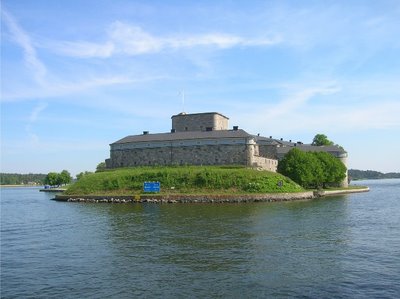 The sentinel's military purpose was abandoned decades ago and now she stands as a traffic warden, offering an imposing presence behind the blue traffic signs directing freighters and liners into the narrow channel on one side and small craft on the other.
The sentinel's military purpose was abandoned decades ago and now she stands as a traffic warden, offering an imposing presence behind the blue traffic signs directing freighters and liners into the narrow channel on one side and small craft on the other. Naturally, it has also become something of a tourist attraction, adding picnic tables and flower gardens to its lethal array of cannon.
Naturally, it has also become something of a tourist attraction, adding picnic tables and flower gardens to its lethal array of cannon. Then as we darted through the narrow channel on the fort's western side, a small plane came ripping through the channel at wavetop height. A billow of thick white smoke swirled behind him, obscurring the ferry's other passengers. Nearly snapping my neck to watch him blast by not more than 30 meters away, I watched him make a perfect swooping climb, rollin gover at the top of his loop in a textbook Immelman.
Then as we darted through the narrow channel on the fort's western side, a small plane came ripping through the channel at wavetop height. A billow of thick white smoke swirled behind him, obscurring the ferry's other passengers. Nearly snapping my neck to watch him blast by not more than 30 meters away, I watched him make a perfect swooping climb, rollin gover at the top of his loop in a textbook Immelman. He was a stunt pilot, out for an afternoon in his snappy little Extra 300. Designed for aerobatics and little else, he took that thing in a dizzying maze of smoke-tailed twists, rolls, dives, and intentional stalls over Waxholm for the next ten minutes or so--a full fuel tank in those little things.
 Passengers on the other ferries (the steamer Stockholm and a flat, motorbarge kind of a car ferry) coming and going from Waxholm were all glued to the one-man airshow.
Passengers on the other ferries (the steamer Stockholm and a flat, motorbarge kind of a car ferry) coming and going from Waxholm were all glued to the one-man airshow. Then it was back up the channel to Stockholm Harbor. Along the way we plowed past the Statoil depot where a small tanker was unloading...
Then it was back up the channel to Stockholm Harbor. Along the way we plowed past the Statoil depot where a small tanker was unloading... ...and the closed facility of one of Statoil's former competitors.
...and the closed facility of one of Statoil's former competitors.
...Speaking of competitors, that's where we came abeam of the comparable passenger ferry, Vaxö. The race was on!
 The burbling bowwave under Vaxö rose up until she had a hissing, white 'bone in her teeth'. As she edged up on us, our skipper opened the throttle a little wider, leaving a nice, greasy, black exhaust cloud astern and plenty of frothing white water. We moved up. Then Vaxö revved her engines up a notch higher and the passengers around me began to notice what was going on. With a lurch, Cinderella II cracked the whip and boy, that little pumpkin carriage really flew!
The burbling bowwave under Vaxö rose up until she had a hissing, white 'bone in her teeth'. As she edged up on us, our skipper opened the throttle a little wider, leaving a nice, greasy, black exhaust cloud astern and plenty of frothing white water. We moved up. Then Vaxö revved her engines up a notch higher and the passengers around me began to notice what was going on. With a lurch, Cinderella II cracked the whip and boy, that little pumpkin carriage really flew! Engines roaring, we edged ahead of the Vaxö, the short, steep waves of our wake closing on her stern quarter. They surged under her stern and she rolled sharply, veering one way and then the other as she surfed over them. Realizing we had her, Vaxö throttled back and swung into the smoother water dead astern of us, admitting defeat. Hurrah for Cinderella II!
Engines roaring, we edged ahead of the Vaxö, the short, steep waves of our wake closing on her stern quarter. They surged under her stern and she rolled sharply, veering one way and then the other as she surfed over them. Realizing we had her, Vaxö throttled back and swung into the smoother water dead astern of us, admitting defeat. Hurrah for Cinderella II! By then we were passing the big shipping warehouses on the outskirts of Stockholm itself. They've been shut down since container shipping took over in the 1970s and 1980s, waiting for the artists in need of studio space, the development investors, and then the residents that will all eventually come looking for them. But for now, the offer a stately but ghostly backdrop for the little passenger steamers to chug past, vessels that remember when these quays were jammed with laden steamships from all over the world.
By then we were passing the big shipping warehouses on the outskirts of Stockholm itself. They've been shut down since container shipping took over in the 1970s and 1980s, waiting for the artists in need of studio space, the development investors, and then the residents that will all eventually come looking for them. But for now, the offer a stately but ghostly backdrop for the little passenger steamers to chug past, vessels that remember when these quays were jammed with laden steamships from all over the world. Those closer to the city already have the big "FOR RENT" signs up and construction crews converting the interiors from bulk storage to cozy apartments and stylish new offices.
Those closer to the city already have the big "FOR RENT" signs up and construction crews converting the interiors from bulk storage to cozy apartments and stylish new offices. Through the roar of our engines came a deep rumble and the trans-Baltic ferry Gabriella came surging by close off the starboard side...
Through the roar of our engines came a deep rumble and the trans-Baltic ferry Gabriella came surging by close off the starboard side... ..her enormous mass throbbing past with the seemingly unstoppable momentum of an iceberg or a ship going down the builder's ways.
..her enormous mass throbbing past with the seemingly unstoppable momentum of an iceberg or a ship going down the builder's ways.  ...a ship of such unfathomable mass.
...a ship of such unfathomable mass. ...until we reached the Jewel of the Seas preparing to get under way. She had all six of her bow and stern thrusters going as she tried to pivot around and get herself pointed towards the open sea again. She was so alarmingly enormous that she could barely turn around in the broad basin of Stockholm Harbor, very nearly grazing the shallows under bow and stern.
...until we reached the Jewel of the Seas preparing to get under way. She had all six of her bow and stern thrusters going as she tried to pivot around and get herself pointed towards the open sea again. She was so alarmingly enormous that she could barely turn around in the broad basin of Stockholm Harbor, very nearly grazing the shallows under bow and stern. Towering some 12 decks above the waterline (passenger decks only, the crew could go higher), her gigantic shadow swept over us as we puttered toward her like an Ostrich chick running home.
Towering some 12 decks above the waterline (passenger decks only, the crew could go higher), her gigantic shadow swept over us as we puttered toward her like an Ostrich chick running home. The rumble of her thrusters was even more powerful than the main engines of the Gabriella, kicking up a churning, bubbling slick of icy water from the harbor bottom.
The rumble of her thrusters was even more powerful than the main engines of the Gabriella, kicking up a churning, bubbling slick of icy water from the harbor bottom. As she swung around, we scuttled past her stern and lit out for the dock, all the glory of having beaten Vaxö being tempered by our sheer insignificance beneath this behemouth.
As she swung around, we scuttled past her stern and lit out for the dock, all the glory of having beaten Vaxö being tempered by our sheer insignificance beneath this behemouth.
And with that, we were back at the pier in Stockholm after a delightful trip into the Stockholm archipelago, through the beauty of those islands and that of Sandhamn in particular.





